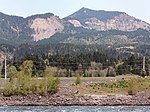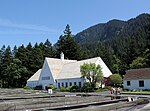Table Mountain (Skamania County, Washington)

Table Mountain is a peak rising on the north side of the Columbia River in Washington state, about 4 miles (6.4 km) north-northwest of Bonneville Dam. It is one of the most spectacular landmarks of the Columbia River Gorge. Its southeast face drops 2,400 feet (730 m) in less than one horizontal mile (1.6 km.), and is topped by an almost vertical 800-foot (240 m) cliff. Table Mountain is joined by the similar Greenleaf Peak to the northeast, and also by Hamilton Mountain to the southwest, which is lower, (2,438 ft or 743 m), but similarly steep and much closer to the Columbia. Together these peaks form an impressive group on the Washington side of the Gorge. Between 1425 and 1450 AD the south side of Table Mountain sheared off and dammed the Columbia River in an event known as the Bonneville Slide.The river soon carved a new bend around to the south, but for a while Native Americans living in the area could walk across. This led to the legend known as the Bridge of the Gods.
Excerpt from the Wikipedia article Table Mountain (Skamania County, Washington) (License: CC BY-SA 3.0, Authors, Images).Table Mountain (Skamania County, Washington)
West Table Mountain Trail,
Geographical coordinates (GPS) Address Nearby Places Show on map
Geographical coordinates (GPS)
| Latitude | Longitude |
|---|---|
| N 45.690672 ° | E -121.983694 ° |
Address
West Table Mountain Trail (Westway Trail)
West Table Mountain Trail
98639
Washington, United States
Open on Google Maps







